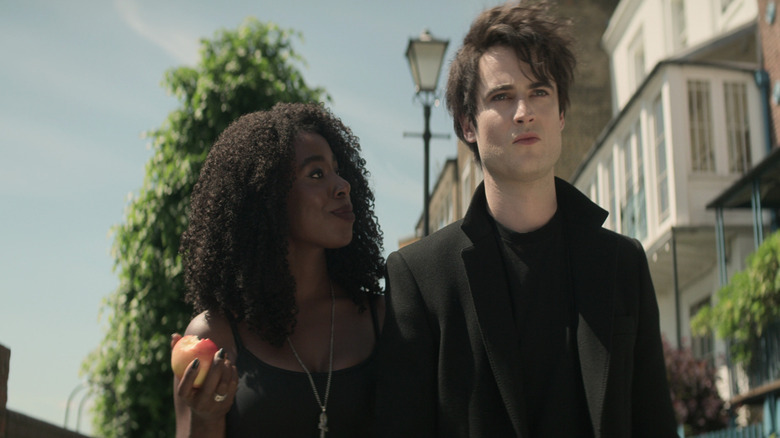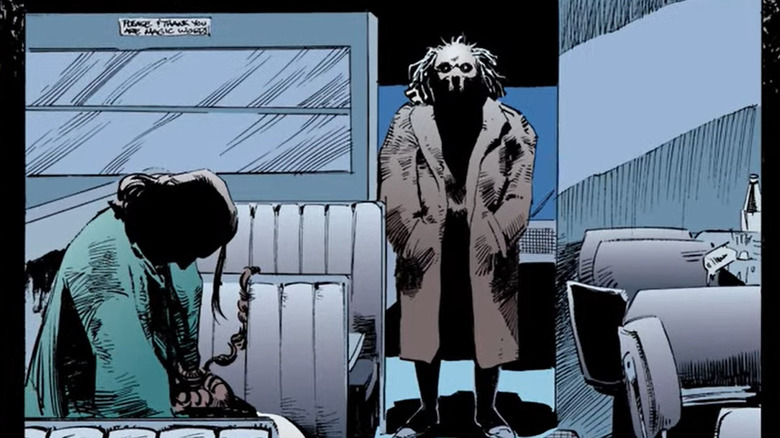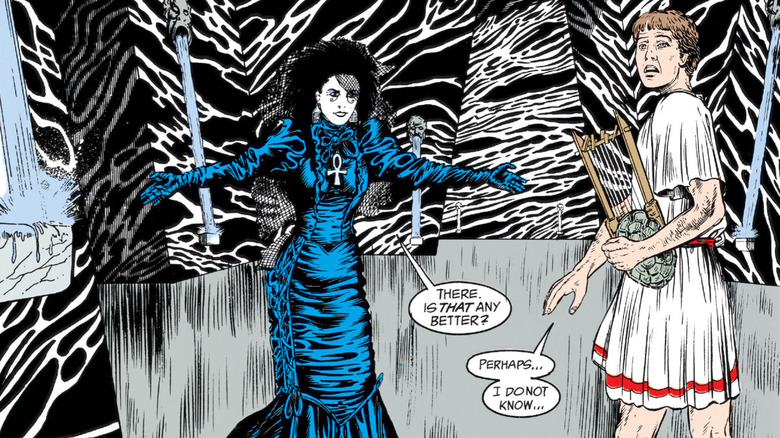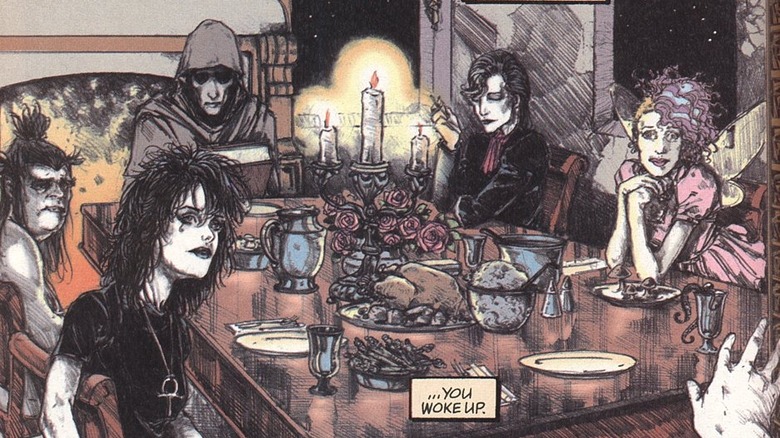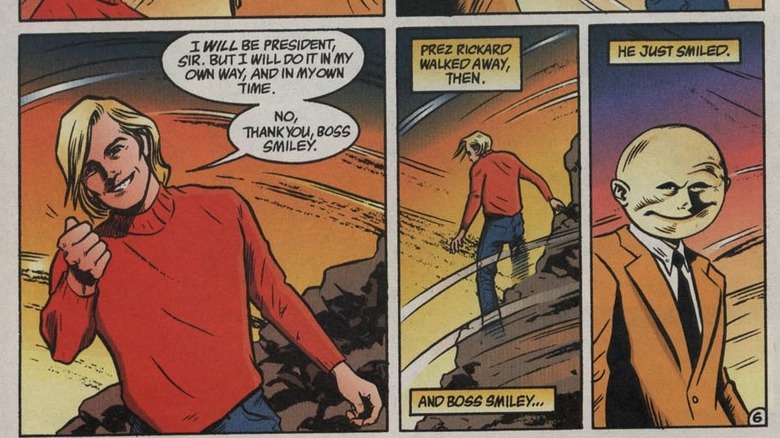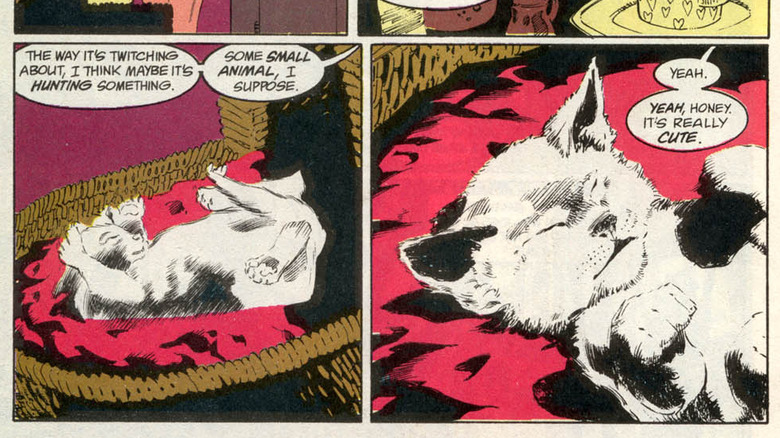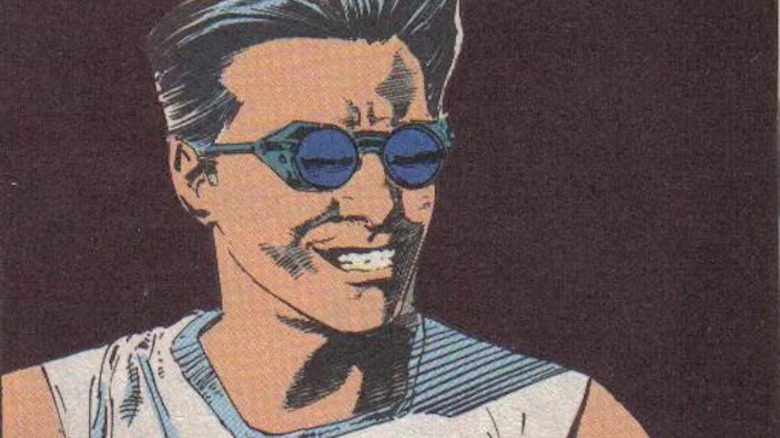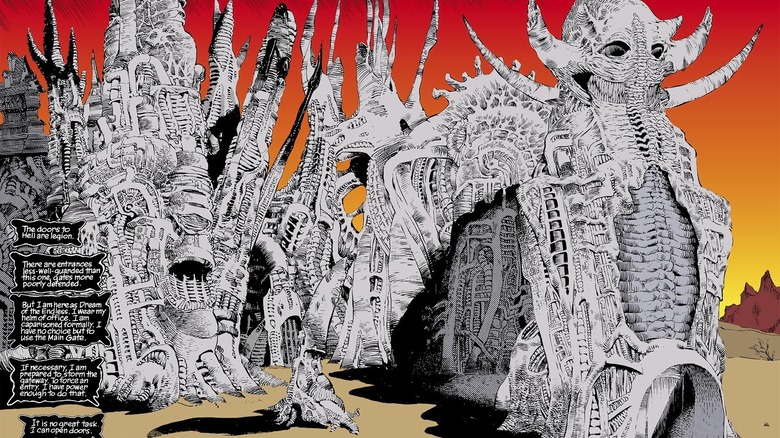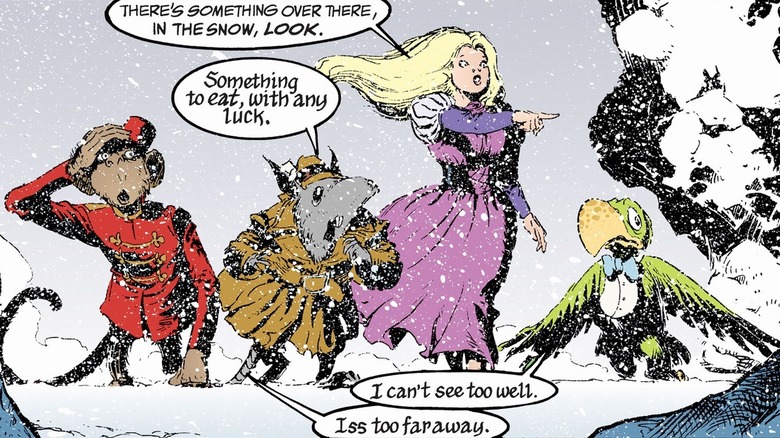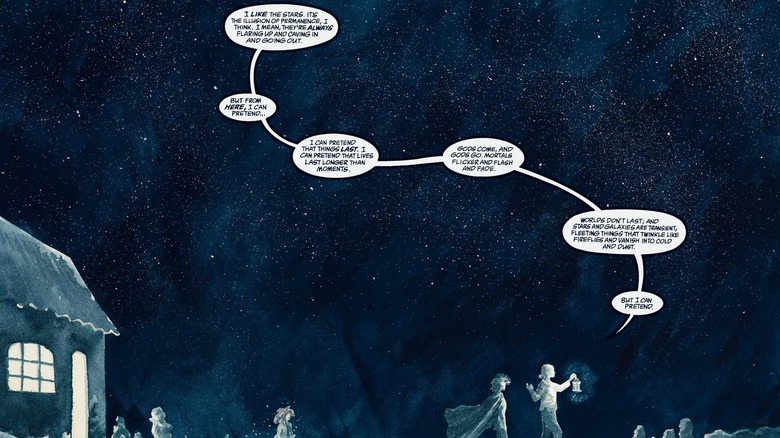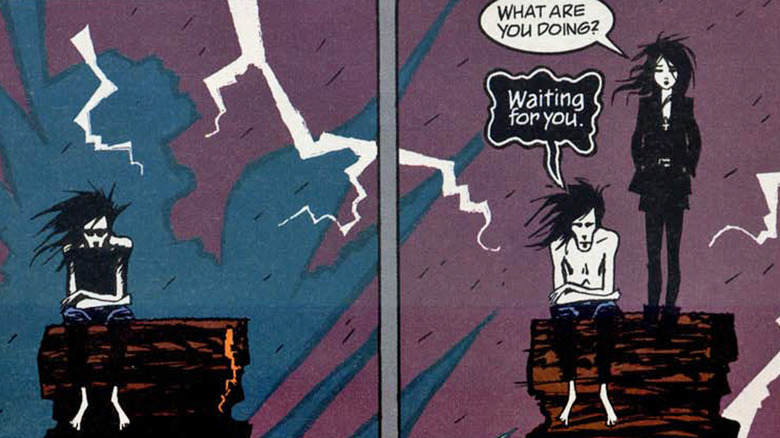The 10 Sandman Volumes, Ranked By How Cool They'll Be To See Adapted To TV
"The Sandman" arrives on Netflix on August 5, with 10 episodes dropping all at once. The debut season will cover the first two volumes of Neil Gaiman's beloved comic series, and we can only hope that things go well enough for the show to be renewed. Most fans agree that the comics get better and better as they go along, so it would be a shame if the show isn't allowed a similar chance to work out any early kinks.
There are 10 volumes in the main "Sandman" series, with storylines spanning across centuries, continents, and realms. Although everyone has their favorite and least favorite, there are no bad chapters to be found. As we dive into the first of hopefully many seasons of "The Sandman," here are those 10 volumes ranked by just how much we're looking forward to seeing them on screen.
10. Preludes and Nocturnes
It's not that anything in this first volume is bad, exactly; it's just that it's far more straightforward than the rest, and far less innovative than the series would become. It also feels a little disjointed from the other volume. In this book, Dream visits Arkham Asylum as part of his quest, something it'd be hard to imagine him doing at pretty much any other part in the story. "Preludes and Nocturnes" seems to be treating Dream almost like a standard superhero, but the series gets better the farther it strays away from that.
It's in the second half of this volume that the series finds its voice, and that's the section we're most looking forward to in season 1. The second half includes the famous horror story "24 Hours," which followed a group of patrons who are trapped inside a diner and are slowly psychologically tortured to death. It's not only a masterpiece of horror, but it's also one that sets Dream apart from other comic book heroes; he does not swoop in just in time to save the innocent people in the diner. He only shows up after the damage is done, and their deaths don't particularly seem to weigh on him.
The other standout is "The Sound of Her Wings," introducing fan-favorite character Death in a surprisingly heartfelt manner. We can expect the new season's sixth episode to cover this story, and we know it was done well enough to make Neil Gaiman cry. So even if "Preludes" is the weakest of the bunch, there's still plenty for us to look forward to.
9. Fables and Reflections
There are three volumes throughout the series that aren't centered around a main ongoing story, but instead consist of standalone tales. This is the second of them, and it's got plenty of standouts. The most memorable — and most important to the overall story — are the stories centered around Orpheus. "The Song of Orpheus" takes the famous Greek myth and retells it in the context of fleshing out Dream's backstory, exploring how he acts as a dad. (Spoiler alert: Dream is a bad father.) Orpheus is Dream's son, and the two characters' relationship with each other is both deeply complicated and extremely important to the overall series.
Some other standouts are "Ramadan," a magical, beautifully illustrated story about the city of Baghdad, both as it is in the early '90s and as it was in the distant past. "Three Septembers and a January" features a surprisingly hopeful story about a man who declares himself the emperor of America, and everyone around him (including Death) is just sort of happy to go along with it. There's also the Johanna Constantine-heavy story "Thermidor," which we know Jenna Coleman's gonna nail if the show gets around to it. There's also a fun, almost child-friendly story near the end called "Parliament of Rooks" where we get to see child Dream and child Death, who are adorable.
Most likely, this collection will be adapted in little bits at a time throughout the show rather than as a serialized string of episodes like the first two volumes in season 1. "Fables & Reflections" doesn't provide any cliffhangers, but it gives the show an opportunity to make some truly amazing standalone episodes of TV.
8. The Wake
The tenth and final volume, "The Wake" is basically an extended epilogue, and a great one at that. Taking place in the aftermath of the universe-shaking moments of the previous entry, this volume is somber and low-key. If the show makes it this far, "The Wake" will most likely make up the final two or three episodes of the final season.
The theme of this volume is that life goes on — major characters are dead, but things are getting back on track. "The Wake" lacks that sense of excitement and momentum that its predecessor had, but that's okay. Instead, it gives us some nice conclusions to plenty of the recurring characters throughout the series, and it ends on a hopeful note. The volume may be heavy with grief, but as the final issues play out, the world of "The Sandman" feels like an overall kinder place than when it started. It's a worthy finale, one that should work just as well on the small screen.
7. World's End
The eighth volume in the series, "World's End" is another collection of standalone stories. Unlike the first two of its kind, however, this one's got a clearer narrative thread: a bunch of strangers across the universe are stranded at a mysterious inn that's dispatched from time and space. To pass the time, they tell each other stories from their lives.
The standout is "The Golden Boy," a story about a version of America where we had a President (named Prez) who genuinely wanted to make the world a better place and then actually went and pulled it off. It's an almost absurdly optimistic story, presenting a world where everything seems to work out for the best. Even the looming villain Boss Smiley doesn't win anything at the end; Dream stops him and lets Prez explore the multiverse.
But perhaps the most memorable story is the final one, where we find out what's causing everyone to get stranded at this inn: somehow, at some point, a key character has died, and the lost travelers get a glimpse of the Endless performing funeral rites. It's an otherworldly moment of dread and sorrow, one that ties all these stories together.
6. Dream Country
The third volume, "Dream Country," is the series' first collection of short stories, and the most memorable. The first one, "Calliope," follows a man with writer's block who's introduced to a particularly disturbing method of fixing his problem. It's a dark contemplation on both male entitlement and on just how much good art is really worth. Another standout is "A Dream of a Thousand Cats," which introduces us to an alternate universe where cats rule the earth, and raises the idea that this version of the world is not as far off as we'd think.
And then there's "A Midnight Summer's Dream," the first comic to ever win the World Fantasy Award for best short fiction. It's a story where Dream has Shakespeare perform his rumored missing play to a group of Dream's otherworldly friends. It's both a thoroughly enjoyable story for any Shakespeare nerds in the audience, as well as being surprisingly vital to the world-building of the series and Dream's larger character arc.
In the introduction for the 30th anniversary edition of the volume, Paul Dini opens up with the question: "Where do you go when you go to sleep?" Dini doesn't know for certain, but he speculates that "Dream Country" does one of the best jobs of any work of fiction of capturing the way dreams feel: "If anyone knows how to walk an easy path through both the dream and waking world, it is Neil Gaiman."
5. The Doll's House
The second volume of the series, "The Doll's House," is responsible for introducing some of the most important characters in the whole series. It brings us Desire (played by Mason Alexander Park in the series), Despair (Donna Preston), the Corinthian (Boyd Holbrook), and plenty more.
It also includes two of the most important short stories in the series' history. The first is "Men of Good Fortune," in which Dream makes a deal with a mortal man named Hob Gadling (Ferdinand Kingsley), offering him immortality in exchange for getting to talk to him once every century. The second is "Tales in the Sand," a story from deep in Dream's past, revealing just how stubborn and cruel he's capable of being.
But what makes "The Doll's House" really stand out is its main story, in which a normal young woman named Rose (Kyo Ra) unknowingly becomes a dream vortex, attracting Dream's attention as she goes on a quest to find her missing brother. She ends up staying at a hotel that turns out to be holding a serial killer convention that same night. Said convention, explored in detail in "Collectors," is one of the most fascinating and memorable issues in the whole series. It's the series at it's darkest, rivaling "24 Hours."
4. Season of Mists
Much like "The Doll's House," the fourth volume introduces a lot of characters who'll be vital to the story going forward. Most notable is Delirium and Destiny, two characters who haven't been cast in the show yet. It also brings back Lucifer (who'll be played by Gwendoline Christie), who makes a brief appearance in "Preludes" but gets a much meatier storyline here. In fact, Lucifer's the one driving the plot in "Season of Mist," when he makes a shocking decision about his role in Hell.
The worldbuilding is wild here, and if the show stays true to the source material's ambitious, evocative artwork, season 2 has the opportunity to be one of the most visually impressive shows on television. "Mists" also explores perhaps the central idea of the series: that you don't have to be anywhere you don't want to be. "Hell's something you carry around you," one character muses, "not somewhere you go." For a story centered around the concept of eternal damnation, it can be surprisingly hopeful.
"Season of Mists" is also a volume that provides a lot of opportunities for the show to expand beyond its source material. One of the best issues is a standalone story centered around a kid stuck in his boarding school during the holidays, and the empty building is now filled with tortured spirits who've wandered out of hell. There's enough material here for a spectacular standalone episode, but there's also plenty more the show could do with the concept. How were other parts of the world affected during this story? Maybe the show will take advantage of the source material to give us some extra stories set in this universe.
3. A Game of You
The fifth volume in the series, "A Game of You" is the "Sandman" series at its most human. Dream is a tertiary character here; he shows up to help out at the end, but the story is centered around the mortal characters of Barbie and Wanda. Barbie in particular will most likely make an appearance in the first season, as she plays a minor but memorable role in "The Doll's House."
What makes this volume particularly unique is how dated it sometimes feels. It's treatment of Wanda, one of the only trans characters in the series (and one of the only trans characters in mainstream comics at the time), is something that'll be interesting to see how the show chooses to navigate. Wanda has her identity as a woman criticized constantly throughout the narrative, and it's hard to imagine it not being heavily updated for a modern audience.
"If I were writing it today, rather than in 1989, when there weren't any trans characters in comics, it would be a different story, I have no doubt," Neil Gaiman once said about it. "But that was the story I wrote in 1989. I got a fair amount of hate mail for putting a trans character in a mainstream comic, and I'm still proud of it, and of Wanda." When asked about the Netflix adaptation, he said he's making sure that there are trans writers included on the staff: "I'm so fascinated to see what a trans writers' room, what stories they would tell with those characters."
2. Brief Lives
The seventh volume in the series, "Brief Lives" is the series at its most thoughtful. It's here we get a proper introduction to Destruction, the last sibling of the Endless we get to meet in the series. Destruction is surprisingly nice and peaceful, and we see him struggling hard with his place in the universe. Like with Lucifer in "Season of Mists," he makes a seemingly radical decision about his place in the universe. This decision baffles Dream, but in hindsight it's clear that the choice was more alluring to him than he liked to let on.
"Brief Lives" is also the volume where we get the most Delirium, which is always fun. She's probably the most entertaining Endless character outside of Dream and Death, and it's always great to see her around. "Brief Lives" might also be one of the funniest entries, as it involves Dream and Delirium going on a quest through the real, modern-day human world. There's a lot of humor mined from the contrast between the Endless and the regular humans, and how silly these gods can look when they have to navigate the regular waking world.
Perhaps most importantly, "Brief Lives" is the last proper, long-form adventure Dream goes on before the finale. It's the final part in the series where things feel normal, before "The Kindly Ones" comes in and tears everything down.
1. The Kindly Ones
The ninth volume, "The Kindly Ones" is the longest and most ambitious chapter of the series. There are a dozen different plot threads going on at once, all of them connecting together in an incredibly satisfying way. The first eight volumes of the series are great, but there is a sense of aimlessness to it all (by design). The story jumps from place to place, character to character, realm to realm. Although it certainly feels like there is a method behind the madness, it isn't until "The Kindly Ones" that the method becomes clear.
This is the climax of the series, and although critics were apparently divided on it when the issues were first being published, time has been kind to the volume. A faithful adaptation could make for one of the most exciting and eventful string of episodes on any Netflix show.
In the end, there's no way for us to know how far the series will get to go, or if they'll also get around to adapting other "Sandman" stories beyond the initial run, like "Overture," "Endless Nights," or "The Dream Hunters." All we know is that Netflix has a gold mine of source material on their hands, and they should take advantage of it. Even if the adaptations of the other volumes are somehow failures, "The Kindly Ones" alone is reason enough for Netflix to stand by the series, no matter what.
